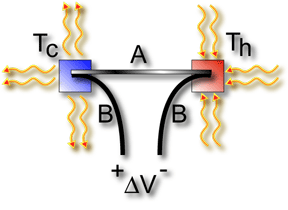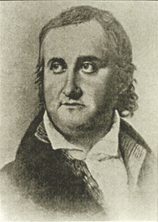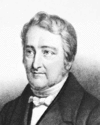History
Seebeck Effect
In 1821 Thomas Johann Seebeck found that a circuit made from two dissimilar metals, with junctions at different temperatures would deflect a compass magnet. Seebeck initially believed this was due to magnetism induced by the temperature difference. However, it was quickly realized that it was an electrical current that is induced, which by Ampere's law deflects the magnet. More specifically, the temperature difference, produces an electric potential (voltage) which can drive an electric current in a closed circuit. Today, this is known as the Seebeck effect. The voltage produced is proportional to the temperature difference between the two junctions. The proportionality constant (a) is known as the Seebeck coefficient, and often referred to as the thermoelectric power or thermopower. The Seebeck voltage does not depend on the distribution of temperature along the metals between the junctions. This is the physical basis for a thermocouple, which is used often for temperature measurement.

PeltierV = a(Th - Tc)
The voltage difference, V, produced across the terminals of an open circuit made from a pair of dissimilar metals, A and B, whose two junctions are held at different temperatures, is directly proportional to the difference between the hot and cold junction temperatures, Th - Tc.

Thomas Johann Seebeck April 9, 1770 – December 10, 1831 Wiki on Seebeck
Peltier Effect
In 1834, a French watchmaker and part time physicist, Jean Charles Athanase Peltier found that an electrical current would produce heating or cooling at the junction of two dissimilar metals. In 1838 Lenz showed that depending on the direction of current flow, heat could be either removed from a junction to freeze water into ice, or by reversing the current, heat can be generated to melt ice. The heat absorbed or created at the junction is proportional to the electrical current. The proportionality constant is known as the Peltier coefficient.

Jean Charles Athanase Peltier Feb. 22, 1785– October 27, 1845 Wiki on Peltier
Thomson Effect
Twenty years later, William Thomson (later Lord Kelvin) issued a comprehensive explanation of the Seebeck and Peltier Effects and described their interrelationship. The Seebeck and Peltier coefficients are related through thermodynamics. The Peltier coefficient is simply the Seebeck coefficient times absolute temperature. This thermodynamic derivation lead Thomson to predict a third thermoelectric effect, now known as the Thomson effect. In the Thomson effect, heat is absorbed or produced when current flows in a material with a temperature gradient. The heat is proportional to both the electric current and the temperature gradient. The proportionality constant, known as the Thomson coefficient is related by thermodynamics to the Seebeck coefficient.

William Thomson (Lord Kelvin) 26 June 1824 – 17 December 1907 Wiki on Thomson

